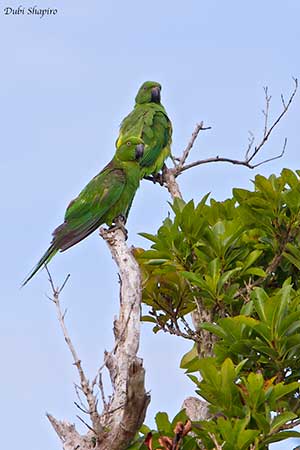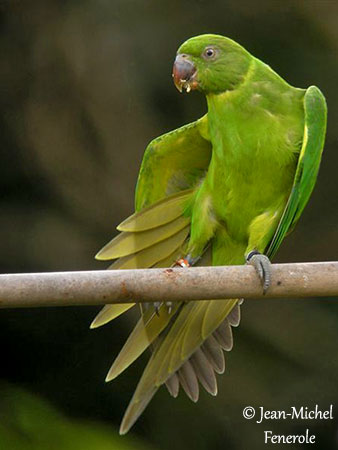
Fr: Perruche de Maurice
Ang: Mauritius Parakeet
All: Mauritiussittich
Esp: Cotorra de Mauricio
Ita: Parrocchetto di Mauritius
Nd: Mauritiusparkiet
Sd: Mauritiusparakit
Photographers:
Jean Michel Fenerole
Photos d’Oiseaux du monde
Dubi Shapiro
Dubi Shapiro Photo Galleries & Dubi Shapiro's Pictures on IBC
Alan & Ann Tate
AA Bird Photography
Text by Nicole Bouglouan
Sources:
HANDBOOK OF THE BIRDS OF THE WORLD vol 4 by Josep del Hoyo-Andrew Elliott-Jordi Sargatal - Lynx Edicions - ISBN: 8487334229
PARROTS OF THE WORLD – An Identification Guide – by Joseph M. Forshaw – Princeton University Press – ISBN 0691092516
Birds of Madagascar and the Indian Ocean Islands Par Roger Safford, Adrian Skerrett, Frank Hawkins – ISBN: 1472924118, 9781472924117- Editeur: Bloomsbury Publishing, 2015
The Birds of Africa: Volume VIII: The Malagasy Region: Madagascar, Seychelles, Comoros, Mascarenes - Par Roger Safford, Frank Hawkins – ISBN: 1408190494, 9781408190494- Editeur: A&C Black, 2013
The Mauritian Wildlife Foundation (MWF)
Reintroducing the pink pigeon and echo parakeet in Mauritius
How the green Echo Parakeet was saved from extinction
Wikipedia, the free encyclopaedia
Echo Parakeet or Mauritius Parakeet
Psittacula eques
Psittaciformes Order – Psittaculidae Family
INTRODUCTION:
The Echo Parakeet was formerly described as a full species endemic to Mauritius and closely related to P. eques from Reunion where it is now extinct. It was also considered as a race of the Rose-ringed Parakeet, but this suggestion was clearly refuted. Reunion and Mauritius species are similar in size and plumage, but they differ in the pink collar of the adult male.
The Echo Parakeet is now endemic to Mauritius where it frequents both native lowland and upland forests. It is a strictly arboreal feeder and forages in native plant species. It typically feeds on leaves, flowers, fruits and seeds. It nests in natural cavities in trees and the species is monogamous.
The Echo Parakeet suffered decline caused by degradation and destruction of its native habitat. Cyclones, introduced plant species and feral mammals are among the main threats. But deterioration of the native forest involving reduction of the foraging areas is the main cause of low breeding success.
However, since 1973, the Echo Parakeet is included in a conservation programme with highly successful captive breeding, with the reintroduction of 139 captive reared birds between 1997 and 2004. Predators are controlled around the nest-sites and all nests are closely guarded and monitored. In addition, the parakeets are fed supplemental food in the wild.
Thanks to these measures, the population made a very rapid increase, with variations due to Psittacine Beak and Feather Disease. But currently, the Echo Parakeet is still classified as Endangered.

DESCRIPTION OF THE BIRD:
Biometrics:
Length: 42 cm
Weight: 167-193 g
The Echo Parakeet adult male has bright emerald green plumage overall. Nape to lower cheeks is suffused bluish to mauve-blue. There is a broad, black stripe across the lower cheeks to the neck sides. This stripe is bordered below by a pink band extending to the hindneck but not encircling it.
On the underparts, chin and sides of throat are black. The green underparts are slightly yellower on lower flanks, belly and undertail-coverts. On the underwing, the flight-feathers are dark grey. The underside of the rectrices is pale bronzy-brown.
The two-tone bill has dark red upper mandible and black lower mandible. The eyes are yellow. Legs and feet are grey.
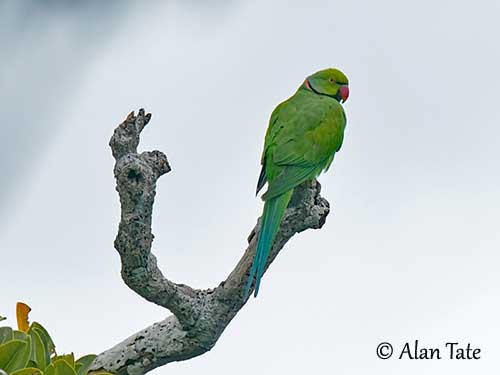
The adult female lacks the head markings and only shows a yellowish-green band on neck sides. She has shorter tail. The bill is entirely black.
The juvenile resembles female but it has short tail. The very young birds have orange bill, becoming black at 4-5 months.
RANGE:
The Echo Parakeet is now restricted to SW of Mauritius, in Black River Gorges area.
HABITAT:
The Echo Parakeet frequents the restricted forested areas with native vegetation in SW (less than 2% of the island). They prefer the large, mature trees such as Canarium paniculatum, Syzygium contractum, Mimusops maxima and Labourdonnaisia species. It also forages in lowland, intermediate and scrub forests.
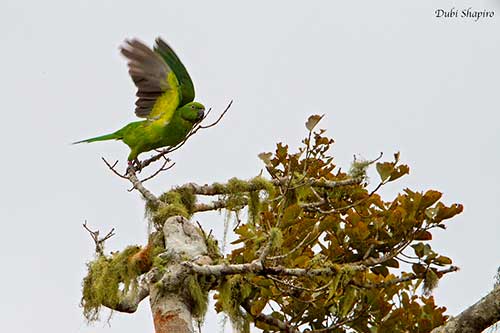
CALLS AND SONGS: SOUNDS BY XENO-CANTO
The Echo Parakeet is typically vocal in the early morning and in the evening before to reach the roost. But this species roosts in smaller groups than other Psittaciformes. It is more vocal during the breeding season, although it can be heard all year round.
The contact call is a low, nasal “chaa-chao, chaa-chao…” at rate of two notes per second. The alarm call is higher-pitched “chee…chee…chee…chee…” with 3-4 notes per second. When disturbed, it gives a short, sharp “ark” but it utters a melodious whistling song from tree perches.
Both adults give a long, drawn-out creaking “yowl” call usually very complex, used as courtship call.
BEHAVIOUR IN THE WILD:
The Echo Parakeet usually forages singly, in pairs or in family groups, or in small flocks of 8-12 individuals. This species feeds on buds, young shoots, leaves, flowers, fruits and seeds, and occasionally twigs, bark and sap, taken on native trees.
It returns to favoured foraging trees but never forages on the ground. It forages in different areas, depending on the season, and feeds mainly on leaves when fruits are scarce.
It often hangs upside-down while feeding, and removes fruits and flowers with the bill, holding the item by a foot white it is eaten.
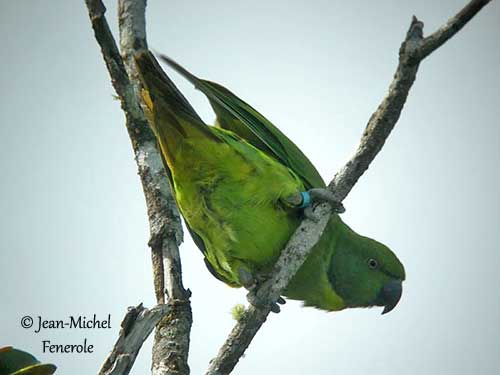
During the courtship displays, the Echo Parakeet displays both neck and head patterns. The feathers of the pink collar are raised, making it very conspicuous, especially during dominance displays. They nest in cavities in large, native trees, at least ten metres above the ground.
The pair maintains the pair-bond through courtship feeding by male to female, billing and preening the feathers of female’s nape.
The Echo Parakeet is sedentary with short movements related to food resources.
The flight is slower and more laboured than that of the Rose-ringed Parakeet, with slower wingbeats. The Echo Parakeet is more manoeuvrable in forest canopy, usually turning in much tighter circles.
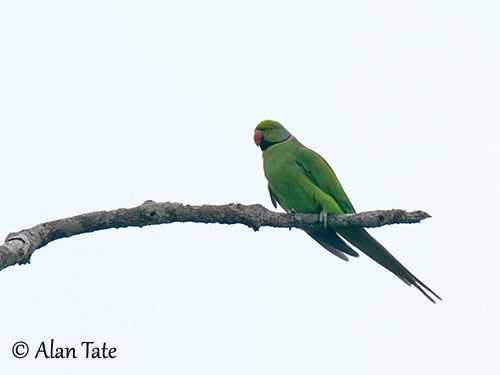
REPRODUCTION OF THIS SPECIES:
The breeding season takes place between September and February, with the laying in late September and early October.
The Echo Parakeet nests in a natural cavity, usually in horizontal branch rather than on vertical trunk of a large, old, native tree. The cavity is at least ten metres above the ground and not exposed to rain and wind.
The female lays 2-4 white, rounded eggs, and usually two young are raised. She incubates alone during 21-25 days, but she is regularly fed by the male outside the cavity. The young are probably fed by both parents, following the first days with the female.
The chicks develop slowly. They are covered by greenish down after 20 days, whereas wing and tail feathers appear after one month. They usually fledge 50-60 days after hatching, and remain near the entrance of the cavity. As soon as they are able to fly, they follow their parents from which they depend for food for 2-3 months after fledging, sometimes as late as March.
Additional adult males may act as “helpers”, feeding the incubating female and the chicks, but they are often rebuffed by the pair. They are often part of floating populations caused by habitat destruction.
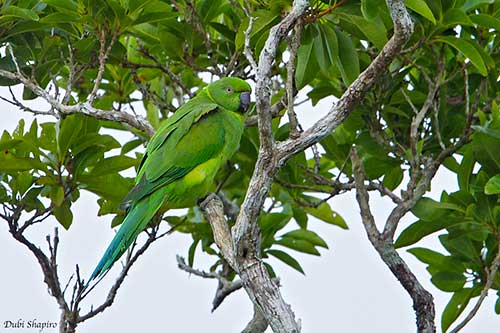
PROTECTION / THREATS / STATUS:
The Echo Parakeet is now confined to a small area of forest in the mountainous SW of Mauritius, today a National Park.
This species was formerly on brink of extinction caused by nest predation and food competition by macaques, nest-site competition from introduced Rose-ringed Parakeet and Common Myna, illegal hunting and impact of cyclones on food resources and nest-sites, in the 1970s and 1980s. There were only some individuals, around ten birds.
Thanks to conservation measures, control of predator’s populations and captive breeding programme, the Echo Parakeet has recovered with a rapid population growth.
Some decrease of the numbers was due to the Psittacine Beak and Feather Disease, but following the breeding season 2011/2012, the population was roughly estimated at 300/350 mature individuals, equivalent to 580 individuals.
The Echo Parakeet is currently classified as Endangered, but conservation actions are still underway.
